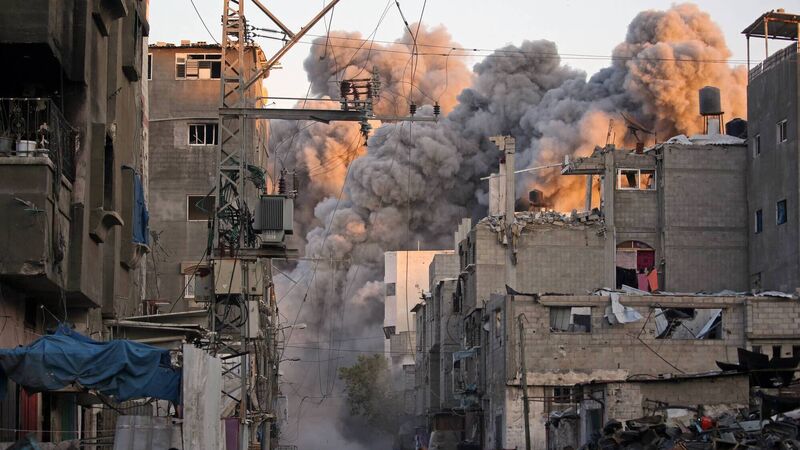Hostage deal imminent, but what’s next for Gaza?

Smoke rises from a building destroyed in an Israeli airstrike at the Bureij camp for Palestinian refugees in the central Gaza Strip on Sunday. In a survey of the population in Gaza, 92% of respondents said they had been displaced by the war, some 25% were living in formal or informal tent shelters with only 12% reported to be living in an undamaged home. Photo: Eyad BABA / AFP via Getty Images
They are calling it the Trump Effect. Just last weekend President elect Donald Trump threatened "hell" for Gaza if the Hamas -held Israeli hostages were not released before his inauguration.
That inauguration is now just six days away. Expectations in the media and on the street in Israel is reaching fever pitch that a deal or truce of some kind is imminent, and that most, if not all the remaining hostages believed to be alive will be soon freed.
466 versus 46,600. These are the two depressing numbers that arguably define the Israeli-Hamas war and that divide Israel from the rest of the world.
466, as of January 14, is the number of days the remaining hostages have been held captive in Gaza by Hamas. This changing daily number is displayed in digital billboards across public squares in Israel.
It is not uncommon to see Israelis in an act of visible solidarity with the hostages, to have the number written in pen on a torn strip masking tape stuck to their sweater or coat.
The daily number appears as a backdrop in multiple news programs and in the masthead of newspapers. 466 is also, of course, the number of days since the war began and Israel unleashed its military power on Gaza.
46,600 is now the estimated number of Palestinians killed as a result of direct and indirect Israeli military action in Gaza since October 7, 2023. Few Israelis in my daily experience in Tel Aviv are either familiar with or readily acknowledge or accept that number.
The medical journal estimates the figure to be 40% higher. Perhaps the true figure will never be known.
The release of the remaining hostages will undoubtedly bring enormous joy to both their families and the wider Israeli public. The end of the war, or at least the end of direct or threat of Israeli military action, will undoubtedly be welcomed by the long-suffering population of Gaza.
But after 15 months of war the big questions on the short- and long-term future of Gaza remain largely unanswered.
A cessation of military action, whilst hugely welcome, will not materially alleviate the immediate and humanitarian catastrophe facing two million residents of Gaza. The logistical task of providing minimum food and health services to stave off a deepening humanitarian catastrophe will remain as daunting as ever.
This task is complicated by Israeli government actions to undermine NGOs providing humanitarian aid or assistance to the population of Gaza.
Talk of reconstruction may sound premature but will inevitably need to be addressed as soon as is practicable — practicable in effect means when the threat of Israeli airstrikes are gone.
The UN has estimated that two-thirds of all buildings in the Gaza Strip have been damaged or destroyed since the war began. The Israeli newspaper in December reported that in a survey of the population in Gaza, 92% of respondents said they had been displaced by the war, some 25% were living in formal or informal tent shelters with only 12% reported to be living in an undamaged home.
Plans for the future administration of the territory also remain as uncertain as ever. Governing political proposals floated over the past year have included everything from a UN peacekeeping force, an international Arab Alliance, direct rule by the Palestinian Authority, to installing an administrative network of civic organizations and tribal councils.
The return of Hamas as a governing party, no matter how indirect, has for obvious reasons been ruled out by Israel.
The far-right coalition partners in Netanyahu's coalition insist on full Israeli control and fantasize about recolonizing parts of the strip. Their leaders, including Itamar Ben Gvir, Minister of security have in the past openly called for ethnic “voluntary” cleansing in Gaza.

Ben Gvir was quoted as saying that the war presented an “opportunity to concentrate on encouraging the migration of the residents of Gaza”, calling such a policy “a correct, just, moral and humane solution”.
Bezalel Smotrich, Minister of Finance was reported late last year as saying at a party meeting that whilst “it may be just and moral” to starve two million Gaza residents until Israeli hostages are returned, “no one in the world would let us”.
Smotrich and Ben Gvir have both threatened repeatedly to bolt the government if a hostage and ceasefire deal with Hamas is agreed upon. On Tuesday, Ben-Gvir boasted that he and Smotrich were the driving forces in thwarting a deal with Hamas over the past 12 months.
Ben-Gvir added:
"Since then, however, additional parties have joined the government which are supporting the deal, and we are no longer the decisive factor."
Most Israelis on what remains of the left or centre-left in Israeli politics would likely rejoice at their departure. For that reason, Ben-Gvir and Smotrich will likely find some excuse to remain. Even their temporary departure is unlikely to bring down the Netanyahu government.
A ruthless terror organization, a complex criminal group, a vehicle for popular resistance to the Occupation, a social welfare distribution network, an embedded ideology, Hamas is arguably all of these things at once, and for that reason, they are unlikely to vanish from the political life of Palestinians in Gaza any time soon.
And what next for Israel? Will Prime Minister Binyamin Netanyahu reap a political dividend from the release of the hostages and be tempted to call an early election? Will a long-term truce allow for a national inquiry into the security failures of October 7?
Perhaps, the most uncertain question of all, how will a second Trump presidency impact Israel, Gaza and the wider Middle East?
- Paul Kearns is a freelance journalist from Dublin who lives in Tel Aviv















